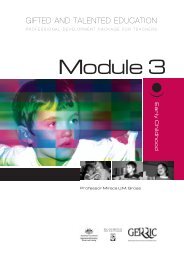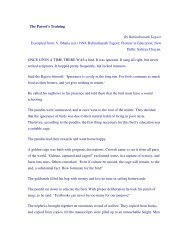to make the work simpler. There were tube-wells and no dearth <strong>of</strong> water. Lift-irrigationhad been introduced in the village and there were canals cutting through fields. Thechildren were totally absorbed learning all about new methods <strong>of</strong> irrigation. They hadread about it in their geography books back home, but it had all been so vague and dry,just a name! Now it made sense and their cousin Devinder knew so much about it all thatthey were amazed. A little further on, they observed the fertilisers that were piled up foruse and also the pesticides. Again these had been names that now became a reality. Forthe first time, they touched the earth with their hands; they dug out weeds; they playedwith grass; they looked at the ears <strong>of</strong> golden wheat; they actually saw other crops. Theymarvelled at the way mounds <strong>of</strong> wheat were stored. They loved everything they saw.They were transformed people.On another day, they went to the village dairy, a completely mechanised unit and theysaw how huge and well-fed the cattle were, how clean the sheds were and howintelligently planned. They saw the fodder and the food the cattle were given. Theyplayed with the cows and the buffaloes till they were gently kicked occasionally and theywould laughingly bounce like footballs in the town! They had heard the phrases ‘thegreen revolution’ and ‘the white revolution’ and their own teacher had tried hard to makethem comprehend, but, perhaps, she too had never been to a village, for otherwise, shewould have made it more vivid and much simpler. Kripal thought a visit to the villagemust be made compulsory for all teachers!The rest <strong>of</strong> the days went by amidst great rejoicing and wonderful discoveries about a‘modern’ village such as this. They saw the village hospital with several amenities, theprimary health centre which cared for the sick. They visited Devinder’s school which wasa small building, but well maintained with lots <strong>of</strong> children and it seemed a happy place.When the bell rang, the children themselves carried their mats out to the open spaces andthey sang songs at the assembly. One little boy read out the news. They were quite wellinformed about happenings in the other parts <strong>of</strong> the country. In the classrooms they sat onmats and had little chowkis in front <strong>of</strong> them. There were not enough black boards ormaps, etc, but Kamaljeet noticed that the handwriting <strong>of</strong> these children was much nicerthan hers’ or her friends’! They first wrote on slates, then with reed pens and ink. Everypage was beautiful. In this school there was even an improvised laboratory <strong>of</strong> tins andcans, and pulleys and bottles for them to learn science. Their teacher had gone to thetown for a Seminar where he learnt all this. Devinder was, <strong>of</strong> course, the bright boy in theschool.During their walks, they noticed that the people in this village were sturdy and wellbuilt.They were hardworking and full <strong>of</strong> new ideas. They saw a repair shop where ayoung man repaired cycles, pump sets, hand tools and many other household thingsbesides. There was a village carpenter who made cots and tables and shelves. The villagemasons were all well-clad and hard at work from morning till evening. The farm womensang as they worked and talked quite loudly. They even had their fights. This place wasfull <strong>of</strong> life, for the people seemed to love a good life.One evening they met the headman <strong>of</strong> the village panchayat, an elderly gentlemanwith a long, glowing grey beard and a golden coloured turban that glittered. Kripal andKamaljeet were a little shy and wondered what they would talk to him about but soon theman put them completely at ease telling them all kinds <strong>of</strong> jokes and sharing big tumblers
<strong>of</strong> sugarcane juice with them. The tumblers in this village, they noticed, were far larger insize than any they had ever seen at home. He told them stories <strong>of</strong> the village andinterspersed them with sayings from the Granth Sahib and tales <strong>of</strong> the Gurus. Thechildren were very impressed and very happy. Another evening they attended a villagewedding with their aunt and enjoyed themselves thoroughly. The people were sohospitable, so warm, so kind.Their uncle then took them to see a Bhangra dance in the village and they weredelighted. People <strong>of</strong> all faiths danced together — Hindu, Muslim and Sikh. Spying twolittle new-comers one <strong>of</strong> the men drew the children into their circle and they danced withthe rest. It was all so different from the Bhangra they had done on the stage at school —so much more fun and joy and no nervousness about the audience!“Was there no poverty in the villages?” Kripal asked. “And are all villages like this?”His uncle explained that about twenty years ago this village too was not producing asmuch wheat or corn as now and even now there were people who had less land <strong>of</strong> theirown; there were also people who did not own any land at all and they were comparativelypoor. But what had happened was that with the coming <strong>of</strong> the radio and some agricultural<strong>of</strong>ficers who gave lessons on improved farming, the farmers <strong>of</strong> this village were willingto change their old habits and learn modern techniques <strong>of</strong> farming. This took time andmany were still doubtful. Harinder Pal himself had to take the lead and show that tractorswould yield better wheat. He had to work hard to convince people about the need forirrigation and fertilisers. But once they saw the results, the villagers were all convinced,and they were so enterprising that in a short while their whole village had gottransformed into what it is today. Even their women had got trained and learnt many newthings about the farm, about cooking, about child-care, health and disease and aboutcleanliness. Uncle added, that the old idea that our villagers are ignorant or unwilling tolearn is no longer true in many parts <strong>of</strong> the country and surely not here. Many adults hadeven learnt to read and write. But more important than that was the fact they had openminds and were willing to enquire, to learn, to change and grow as fast as possible. Theywere adventurous and they were happy, buoyant and contented. This visit was such aneye-opener to the children that they came back, delighted, and excited and talked about itfor days. They also became humble and more sensitive to life in a village. They hadgrown to love their cousin Devinder and promised to return every holiday.Have you ever visited a village in your part <strong>of</strong> the country? Have your experiencesbeen somewhat like those <strong>of</strong> these two children? What more can you add that can give usa glimpse <strong>of</strong> a prosperous village?If different, what have you seen that has perhaps made you sad? Let us remember that,alas, not all our villages are as prosperous as some <strong>of</strong> these. We do have rich villages thatproduce wheat, rice, cotton, maize, pulses, and grains <strong>of</strong> all sorts. We do have tea andc<strong>of</strong>fee estates and so on. But only some are prosperous. In the vast majority <strong>of</strong> them thepeople are very poor and can hardly have one meal a day. Not all villagers own land.Some do, others work for them, till the soil and do all the hard work, but are paid verylittle. There is exploitation. There is poverty, squalor, dirt, disease. There is superstition.Very few girls go to school. Girls are regarded as inferior to boys. Women live in greathardship. Often men indulge in drink. There is great sorrow. These are also the realitieswe see in villages. But the question is that if in twenty years some villages like
- Page 1 and 2: THINKING TOGETHERAhalya ChariNATION
- Page 3 and 4: There is, therefore, a different ap
- Page 5 and 6: 20. On Beauty21. When Trees Hold a
- Page 7 and 8: dustbin, lifting a child that had f
- Page 9 and 10: thoughtless and conceited and she w
- Page 11 and 12: his hair combed back neatly. Anita
- Page 13 and 14: that require the use of the hands.
- Page 15 and 16: slightly bigger decision like ‘Sh
- Page 18 and 19: I want to share with you one incide
- Page 20 and 21: Yet another teacher said, “I don
- Page 22 and 23: them but can one have fun even whil
- Page 24 and 25: studies and they were angry that th
- Page 26 and 27: The entire evening and all the item
- Page 28 and 29: know best what your hurts are at th
- Page 30 and 31: working with your hands there is no
- Page 32 and 33: job. In fact, since his school days
- Page 34 and 35: Bachhu lived in the hills of the no
- Page 36 and 37: important for growing children. His
- Page 38 and 39: through design books and his eyes n
- Page 40 and 41: tamarind, cotton, kadam, cinnamon,
- Page 42 and 43: vision of education. Children loved
- Page 44 and 45: from which he draws his energy. In
- Page 46 and 47: “What about you, Lalitha? Aren’
- Page 48 and 49: you hear the whine of a dog hit by
- Page 50 and 51: stuffed with the opinions and belie
- Page 54 and 55: Devinder’s can he such happy, pro
- Page 56 and 57: means that if you are an Englishman
- Page 58 and 59: TEACHER: No, he can’t. He is resp
- Page 60 and 61: serene face. He also learnt at scho
- Page 62: not calculate and solve elaborate m
















